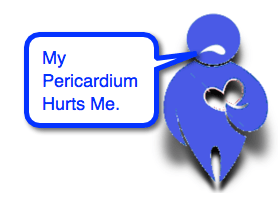Pericarditis
Chest pain as a complaint warrants great concern in our adult patients, but in children it is often perceived as benign by default. Naturally, there are a number of entities that are of concern that should be considered before we jump to the “it’s costochondritis” speech with families. We have discussed several causes of chest pain in the past (ex, myocarditis, pulmonary embolism, pneumomediastinum, spontaneous pneumothorax), but one that deserves some attention now is Pericarditis.
Pericardium:
- Pericardium has a visceral and parietal layer
- Small amount of fluid (~35mL of ultra filtrate of plasma) contained within sac normally.
- Functions to:
- Maintain orientation between great vessels and heart
- Prevent sudden dilation of ventricle during exercise/exertion
- Assist in atrial filling (negative intra-pericardial pressure)
- Acts as barrier to spread of infections from lungs to heart.
Pericarditis Recent Numbers:
- True incidence of pericarditis is likely under-estimated in children.
- Male predominance (~80%) [Shakti, 2014]
- Male adolescents constituted ~50% of this study group
- Median Age = 14.5 years (range 7 – 17 years) [Shakti, 2014]
- Pericardial drainage was performed in 17.7% of cases [Shakti, 2014]
- Generally a benign, self-limited course.
- 60% recover in 1 week.
- ~30% can develop recurrent pain.
- Readmission occurred in ~10% of cases. [Shakti, 2014]
- No therapeutic or underlying medical condition more associated with readmissions.
Pericarditis Causes:
- Idiopathic (37%-68%) [Ratnapalan, 2011]
- Infections
- Viral (ex, coxsackievirus, EPV, influenza)
- Bacterial
- Fungal
- Metabolic (ex, uremia, myxedema)
- Rheumatic Disease (ex, Lupus, Rheumatic Fever) (~30%) [Roodpeyma, 2000]
- Neoplastic Disease (~10%) [Roodpeyma, 2000]
- Medication Adverse Reaction (ex, hydralazine, isoniazid)
- Trauma
Pericarditis Presentations:
- “Classic Triad” = fever, dyspnea, and chest pain
- Of course, that sounds like pneumonia also.
- 96% of acute pericarditis present with Chest Pain [Ratnapalan, 2011]
- Often described as sharp, but can be dull.
- Often worse with leaning backward, deep breaths, or coughing.
- Often referred pain to shoulder, epigastric region, and/or back.
- 56% presented with fever [Ratnapalan, 2011]
- Pericardial friction rub may not be heard
- Especially if there is a large effusion
- Heard best during expiration and with child leaning forward.
Pericarditis Evaluation:
- ALL children in one study had abnormal ECGs [Ratnapalan, 2011]
- May not have the classic diffuse ST elevations with PR depressions and no reciprocal changes… but may have subtle T wave flattening.
- See Dr. Mattu’s prior talks on ECG changes (Pericarditis vs STEMI; Spodick Sign)
- Low threshold to obtain ECG in kids with Chest Pain.
- CXR – can be helpful, but may be normal in up to 40% [Ratnapalan, 2011]
- U/S – 82% had a pericardial effusion [Ratnapalan, 2011]
- Labs:
- No lab diagnoses pericarditis.
- Several can help “complete the picture” that was started by the history and physical exam and supported by ECG and U/S.
- ESR, CRP, and Troponin have all been shown to be elevated with acute pericarditis.
Pericarditis Therapy
- First make sure there is no cardiovascular compromise (i.e., tamponade).
- Again, bedside U/S is very helpful here!
- Pericardiocentesis:
- NOT indicated for routine investigations / management. [Durani,2010]
- Do use for tamponade physiology.
- Do use if concern for bacterial pericarditis.
- Control inflammation.
- NSAIDs are 1st-line.
- Corticosteroids are usually reserved for severe or refractory cases.
- Colchicine has been recently shown to be helpful in adults with acute pericarditis (See CMC Core Concept), but this is not yet an often used therapy in children. [Shakti, 2014]
- Treat infection if present!
- If bacterial pericarditis is suspected, initial treatment should include antistaphylococcal agents.
- Delayed therapy in these cases is associated with high morbidity and mortality.
- Contemplate other causes… is this uremia, is this Lupus?
References
Shakti D1, Hehn R1, Gauvreau K1, Sundel RP2, Newburger JW1. Idiopathic pericarditis and pericardial effusion in children: contemporary epidemiology and management. J Am Heart Assoc. 2014 Nov 7;3(6):e001483. PMID: 25380671. [PubMed] [Read by QxMD]
Brown JL1, Hirsh DA, Mahle WT. Use of troponin as a screen for chest pain in the pediatric emergency department. Pediatr Cardiol. 2012 Feb;33(2):337-42. PMID: 22089143. [PubMed] [Read by QxMD]
Ratnapalan S1, Brown K, Benson L. Children presenting with acute pericarditis to the emergency department. Pediatr Emerg Care. 2011 Jul;27(7):581-5. PMID: 21712753. [PubMed] [Read by QxMD]
Drossner DM1, Hirsh DA, Sturm JJ, Mahle WT, Goo DJ, Massey R, Simon HK. Cardiac disease in pediatric patients presenting to a pediatric ED with chest pain. Am J Emerg Med. 2011 Jul;29(6):632-8. PMID: 20627219. [PubMed] [Read by QxMD]
Roodpeyma S1, Sadeghian N. Acute pericarditis in childhood: a 10-year experience. Pediatr Cardiol. 2000 Jul-Aug;21(4):363-7. PMID: 10865014. [PubMed] [Read by QxMD]
Durani Y1, Giordano K, Goudie BW. Myocarditis and pericarditis in children. Pediatr Clin North Am. 2010 Dec;57(6):1281-303. PMID: 21111118. [PubMed] [Read by QxMD]




[…] http://pedemmorsels.com/pericarditis/ […]